�
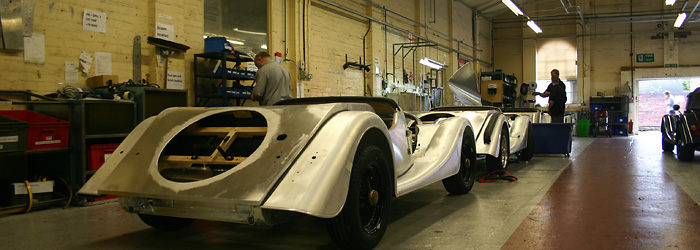
�
A broad red "carpet" designates the official route of Morgan factory tours.
�
Tour Morgan Motor Company's Factory in its 100th Year
� ��
as published in BritishV8 Magazine, Volume XXI Issue 2, December 2013�
�
by Curtis Jacobson�
�
Change in the Works
��
Morgan Motor Company is celebrating 100 years of production at its workshops on�
Pickersleigh Road in the charming spa town of Malvern Link. This article�
puts the celebration in context. On the first Monday of October 2013, BritishV8�
dropped in and toured the Morgan works. Our report shows what has always made Morgan�
special and also what changes are occurring at Great Britain's oldest independent�
automaker.�
�
Morgan builds uncommonly lightweight and nimble sportscars, and they do so with�
old-fashioned manufacturing techniques. Along our tour route we saw wood shaped with�
rasps, chisels, and planes. Aluminum body panels were cut and formed with handtools.�
Leather upholstery was hand sewn. On the other hand, elaborate and curvaceous aluminum�
fenders are now made by a partner company nearby where instead of using conventional�
mechanical presses, air pressure is used to blow super-heated aluminum into one-sided�
steel molds. CNC machines mill wooden assemblies with great precision, but our tour�
didn't pass into that part of Morgan's plant so our overall impression was "pre-industrial".�
There's never been a mechanized assembly line at Morgan. Cars may or may not move in a�
predictable order from one workstation to another. Morgan doesn't throw around�
fashionable industrial engineering terms like "kanban". They trust skilled workers to�
work calmly and smartly together. �
�
And the company is booming! In 2012 they built almost 1000 vehicles. That's a build�
rate unseen since before World War II. 2013 has been an even busier year. Morgan has�
introduced new models and they're entering new markets. A new Morgan dealership has just�
opened in China's Shandong province. Yet Morgan seems to be standing on a dangerous�
precipice in at least two respects.�
�
The first danger may be more omen than actual. Ash wood is a critical component of every�
Morgan vehicle. A terrible fungal blight is rampaging across Europe and Great Britain.�
Asian spores travel on a foul wind. Many millions of trees are affected. At some point in�
the foreseeable future Morgan will have to import ash wood from much farther afield and/or�
utilize a different species. �
�
�
More importantly, Morgan management is in transition. The company is family-owned�
and has always had at least one family member engaged in day-to-day management. That changed�
on October 16th. Ostensibly due to a schism between family members, Charles Morgan has been�
banished. In his term as Managing Director, this grandson of the firm's founder had been�
credited with doubling the firm's sales. He had certainly been the driving force behind�
diversification of the model range and behind Morgan's return to motor racing. His�
charismatic presence has been popular with factory workers and customers alike. BritishV8 is�
in no position to predict implications of the change. At this time, we can only report that�
change is underway.�
�
Change is unfamiliar at Morgan. The Morgan Motor Company was founded by Henry Frederick Stanley�
Morgan. "H.F.S." had previously studied engineering and had served as an apprentice at the huge�
G.W.R. railway factory in Swindon. Production of the Morgan "Runabout" three wheeler model began�
in 1911 at H.F.S. Morgan's garage business on Worcester Road. That garage was soon outgrown.�
In 1914, Morgan bought the site BritishV8 visited on Pickersleigh Road. Production moved into a�
new building there shortly after WW1 ended. H.F.S. Morgan continued to run the firm until 1959.�
Then, his son Peter led until 2003. From 2003 to 2006, Alan Garnett served as Managing Director,�
but Charles was there helping. Charles Morgan became part of a four-man management team in 2006,�
and was named Managing Director in 2010. The Pickersleigh Road works has been the physical and�
emotional heart of the company ever since it opened. Morgan has been sheltered in these old�
brick buildings.�
�
Below, we present the Morgan factory in approximately 100 captioned photos.�
The company's products are central to the story, so we'll start with an overview:�
�
Three Current Model Ranges: Classic, Aero, and Three Wheeler
� �
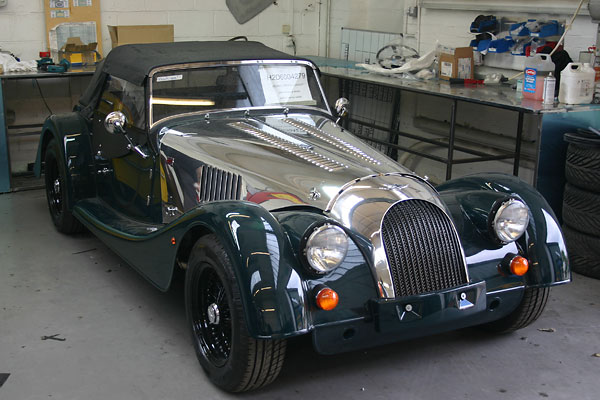
�
The Classic range includes "4/4", "Plus 4", "Roadster" (V6), and "Plus 8" models.
�
This range has evolved over more than three quarters of a century.
�
Pictured: one of only fifty spectacular 2014 "Brooklands Edition" Roadsters.
�
(I wish I had stepped over and latched its bonnet down tight for this photo.)
�
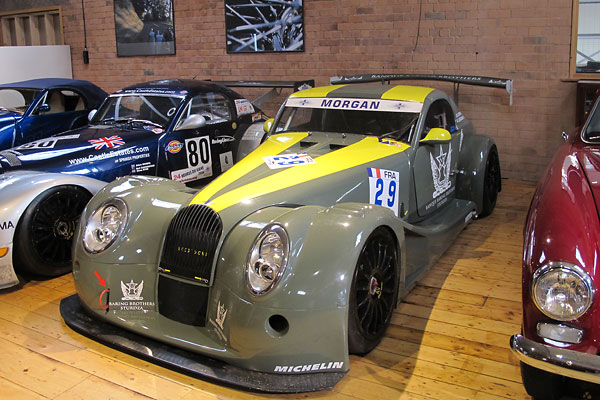
�
Launched in 2000, the Aero range is a new Morgan for a new century. The Morgan
�
website and current brochures show "Supersport" (targa) and "Coupe" (GT) variants
�
exclusively. During our tour we also saw a proper soft-top convertible version.
�
Aero models feature aluminum chassis and they're powered by BMW V8 engines.
�
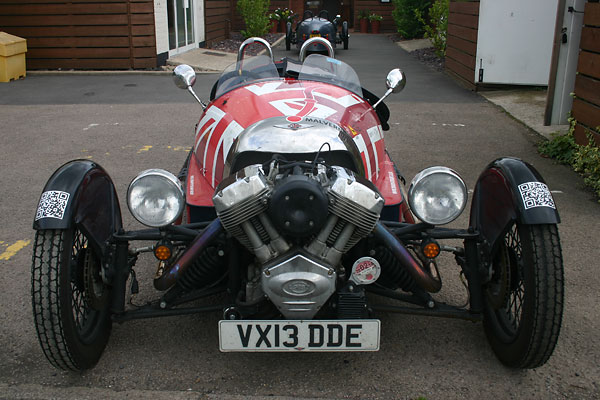
�
The Three Wheeler range was launched in 2011. Already, over 1000 have been delivered!
�
With the Three Wheeler, Morgan has returned to the United States market. It's considered
�
a motorcycle, so it doesn't have to be certified to U.S. crashworthiness standards.
�
In addition to standard and bespoke offerings, "Superdry" and "Brooklands"
�
themed special editions are currently available.
�
Meeting Outside the Reception Building
� �
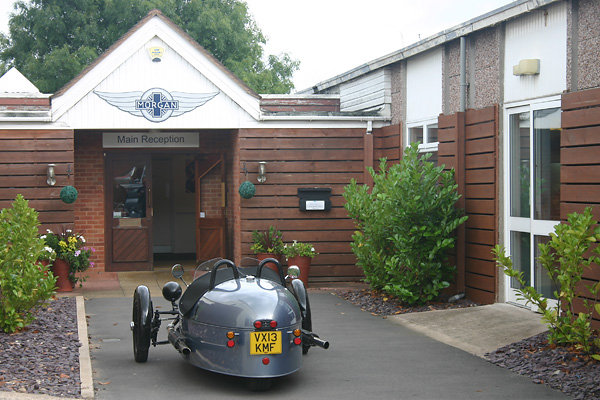
�
The Morgan Motor Company Visitor and Conference Center is where guided tours start
�
after a brief welcome video. Tours cost £12.50 per person and MUST be pre-booked.
�
Details may be found at www.morgan-motor.co.uk. Phone: +44(0)1684573104.
�
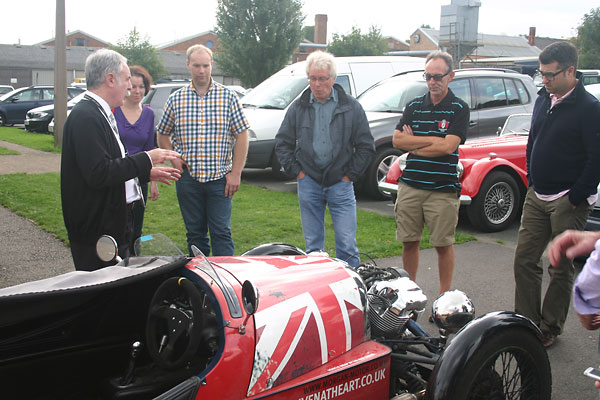
�
Tour guide Robert Dance led us outside where we gathered around examples of Morgan's
�
newest model, simply called "Three Wheeler". It's a time machine which lets you travel
�
back to when the company started. Morgan built three wheelers for 25 years before
�
introducing their first four wheeled automobile.
�
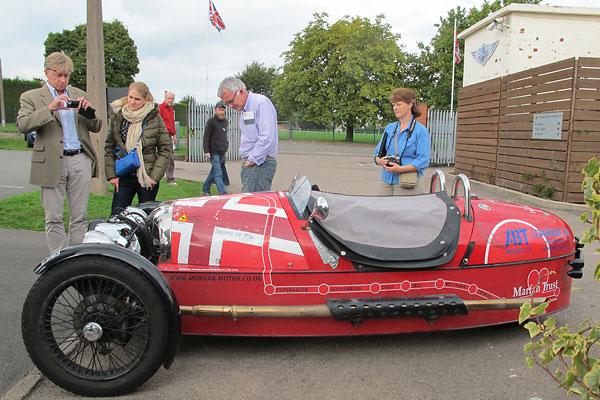
�
Morgan's three wheelers declined in popularity after WWII. Morgan finally discontinued
�
production of them in 1953 to focus exclusively on four wheeled models.
�
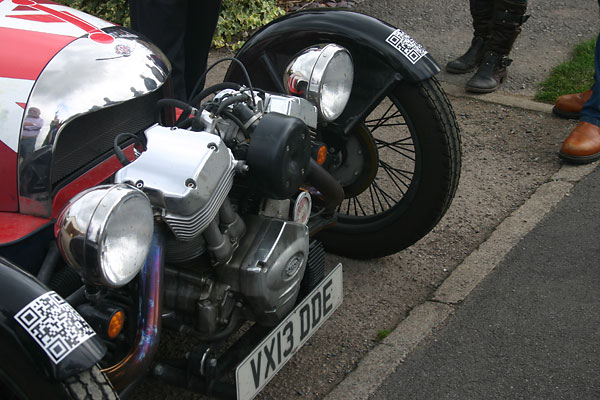
�
An S&S Cycle produced 1976cc V-twin engine coupled to a Mazda 5-speed gearbox provides
�
82 bhp at 5250 rpm, 0 to 62 mph in 6.0 seconds, and 115 mph top speed. It weighs just 1157#!
�
In England: £25,950 base price, plus VAT. In U.S.A: ~$45,000.
�
Walking Across The Grounds
� �
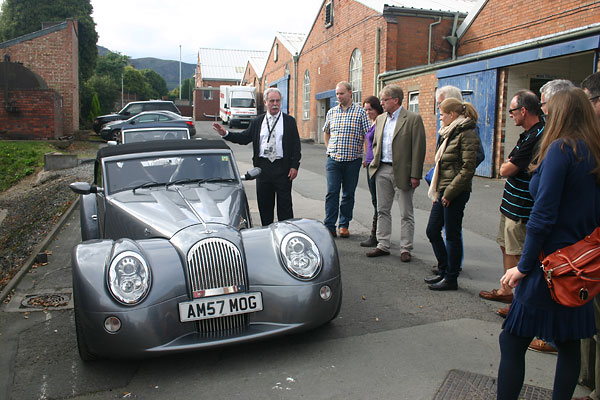
�
That's a new "Aero" convertible in the foreground. But please note the buildings to the right.
�
Our tour started in the furthest one, then proceeded downhill through four more before
�
crossing the road to visit three on the left. The natural incline is used to advantage:
�
cars are generally hand-pushed downhill from building to building as they're assembled.
�
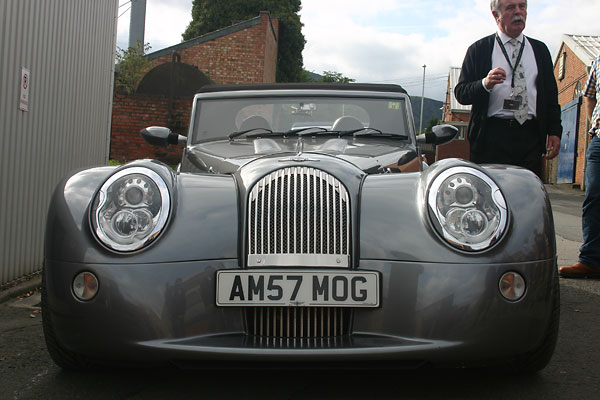
�
"21st Century Coach Building" is the description our guide used. The Aero range features
�
elaborate "Super Plastic-Formed" (SPF) aluminum bodywork. Super-heated aluminum panels
�
are formed onto (or into) one-sided steel molds, primarily by application of pressurized
�
air. The SPF process is now used for the sweeping fenders of the Classic models too.
�
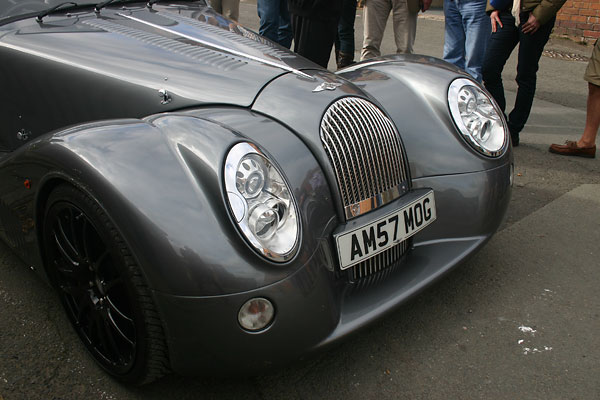
�
Prime mover? The Aero range comes with a 4799cc BMW V8 rated 367 bhp at 6500rpm and 370 lb/ft
�
of torque. Customers are given their choice of a BMW 6-speed manual or a ZF 6-speed automatic.
�
which produce ratings of 23mpg (manual) or 26mpg (automatic) combined average fuel economy.
�
Width 1751mm. Dry weight 2601#. ABS, cruise control, electronic brake distribution, and drag
�
torque control are all standard features. All leather components are hand-stitched.
�
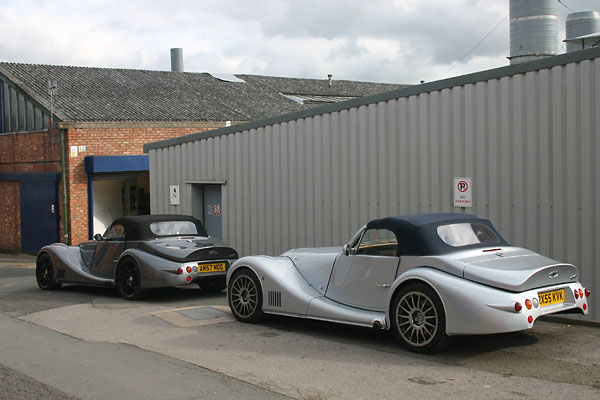
�
Base price for an Aero Coupe is currently £83,292, to which you may need to add Britain's
�
Value Added Tax. (That converts to about $135,000 U.S. dollars before taxes, etc.)
�
However, this photo shows Aero convertibles, not coupes and not Supersports.
�
This model isn't currently listed in Morgan sales literature.
�
Step Into Morgan Headquarters
� �
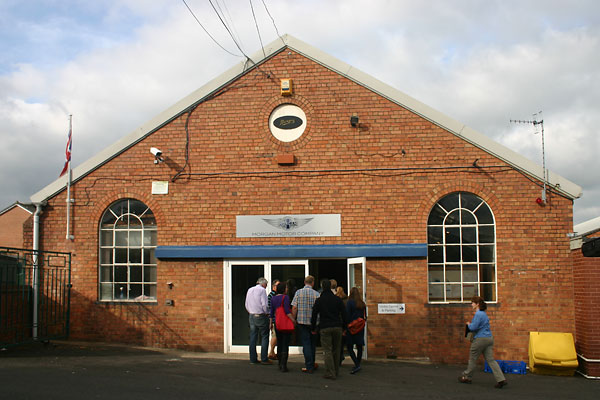
�
Headquarter offices are housed in the Pickersleigh Road site's original production
�
building. We stepped inside the lobby to see a small display of historic Morgans.
�
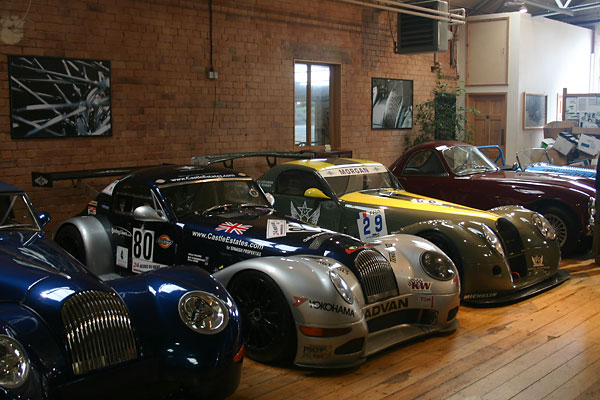
�
The #80 Aero 8 GTN had good potential and bad luck. It completed 222 laps in the 2004
�
24 Hours of Le Mans race, but the winner that year completed 379 laps. The #29 Aero
�
and its teammate (not shown here) split victories in the first two races of the 2009 FIA
�
European GT3 Championship Series, upsetting factory-supported Audi R8LMS and Aston
�
Martin DBRS9 racecars and a very large field. That two-car Morgan team ultimately
�
finished fifth of fifteen teams in points over twelve Championship Series races.
�
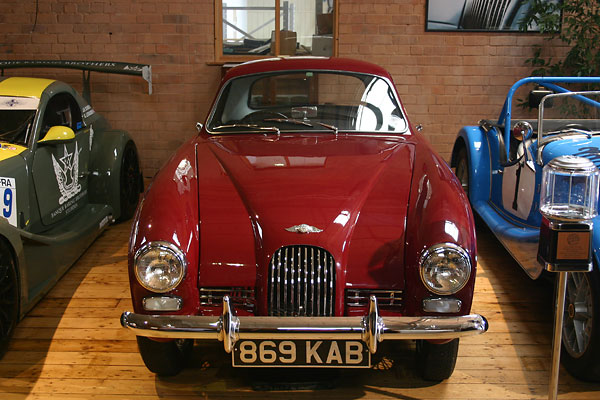
�
This is my favorite Morgan model, the "Plus 4 Plus". Sadly, stars were out of alignment for it.
�
Introduced in 1963, only 26 of these were ordered and built. (All 26 are accounted for. At least
�
one still vintage races in Europe.) Look beneath this Plus 4 Plus' beautiful fixed head coupe body
�
and you'll find a normal Plus 4 chassis and Triumph engine. Morgan fans didn't embrace this model,
�
and it didn't help Morgan sell into new markets or niches either. If it had been introduced a few
�
years earlier, potential customers might have compared it favorably to heavier cars such as the
�
(similarly Triumph powered) Peerless GT.�
On the other hand, if an equally handsome coupe body
�
had been offered on the Plus 8 chassis... well, we'll never know what might have happened.
�
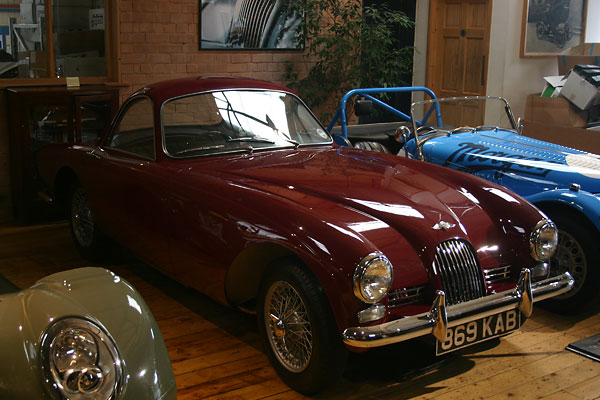
�
Triumph discontinued their 2138cc four cylinder engine in 1968, which left Morgan scrambling
�
to find a suitable replacement. Ulitmately, they sourced a Ford engine for the Plus 4 model.
�
While beating the bushes, they were also offered Rover's fantastic aluminum V8. An opportunity
�
they couldn't resist, the Morgan Plus 8 model was an instant success. (More here.) With Rover
�
V8, the Plus 8 served as Morgan's flagship model for 36 years. Compared to a contemporary
�
Plus 4, the 1968 Morgan Plus 8 chassis was stretched 2" in length. Bodies were similar except
�
steel floors were installed in lieu of wood.
�
Chassis Assembly
� �
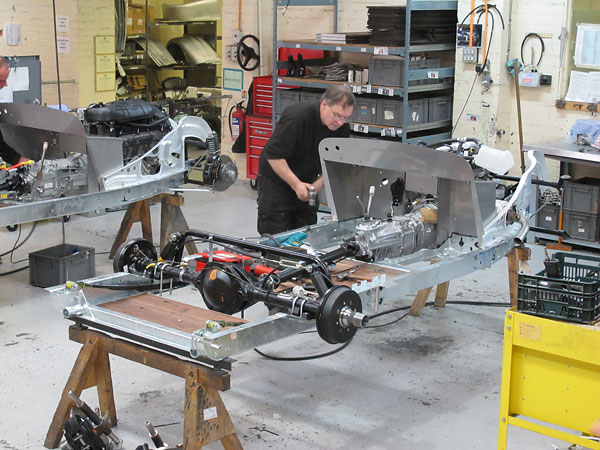
�
The world's longest running production vehicle, Morgan's "4/4" (four wheels and four cylinders)
�
entered production in 1936. The earliest 4/4 Morgans were originally powered by 1122cc Coventry
�
Climax engines. When production resumed after WWII, Standard 1267cc engines were used.
�
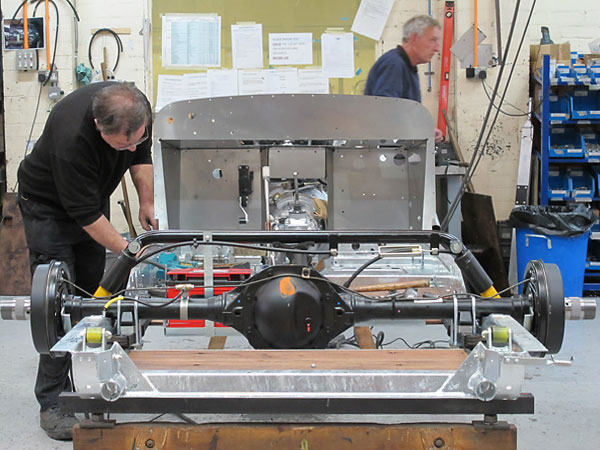
�
Since 2009, the 4/4 model has been powered by Ford Sigma 1595cc 4-cylinder engines which
�
deliver 110 bhp at 6000rpm and 97 lb/ft of torque. Mazda 5-speed gearboxes help these
�
lightweight (1753#) cars achieve a 44.1mpg average fuel economy rating. Width: 1630mm.
�
£27,563 base price, plus VAT.
�
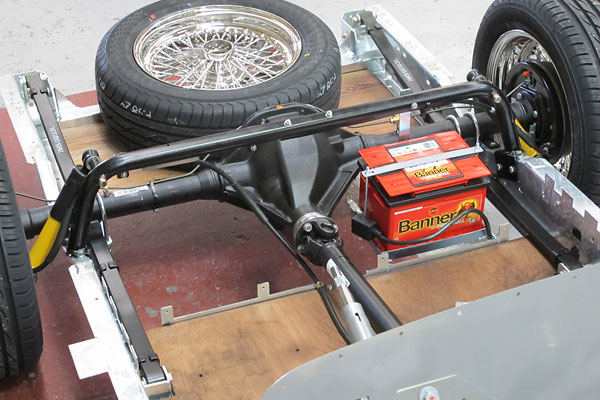
�
Frame and suspension designs have been remarkably stable over the years. Morgan ladder frames
�
are low and wide, with z-section framerails. Note that they're galvanized.
�
Rear axles sit atop underslung leafsprings. Floorboards really are boards.
�
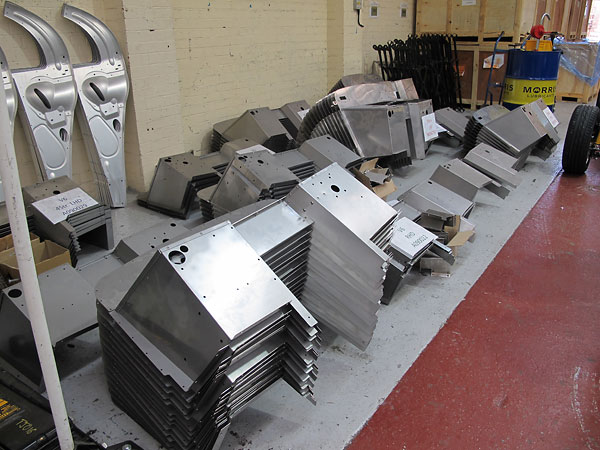
�
We're at the firewall installation workstation, and just across the walkway we observe
�
roughly two month's supply of firewalls. These parts are stainless steel, not aluminum.
�
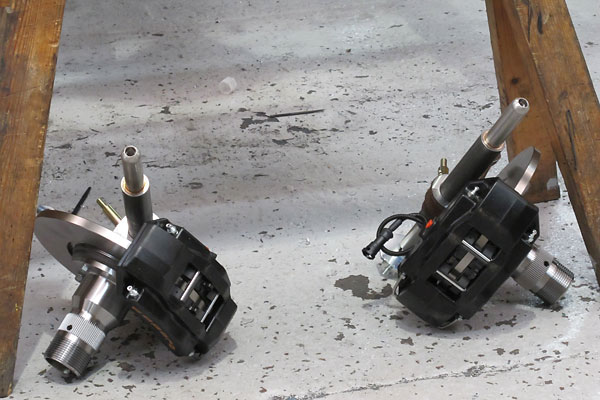
�
Sliding pillar front suspensions have been among the most characteristic and unusual features
�
of Morgan cars from the beginning. Hub carriers slide up and down, maintaining a fixed camber
�
angle regardless of bumps and body roll.
�
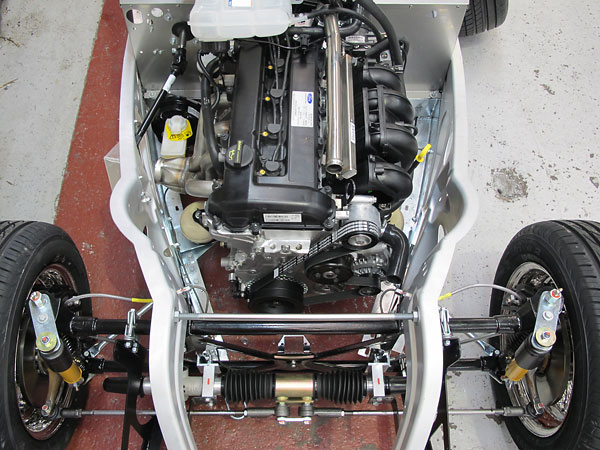
�
Coil springs are mounted on the pillars, above and below the hub carrier assemblies.
�
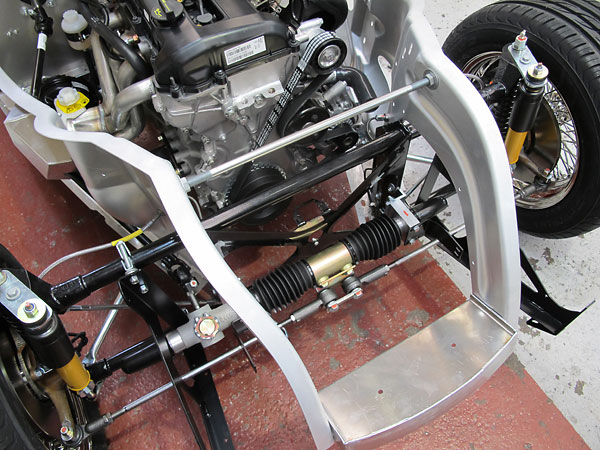
�
Later model Morgans have very long steering links, protruding out from the center of
�
their steering racks. The length of these links helps reduce bump steer tendencies.
�
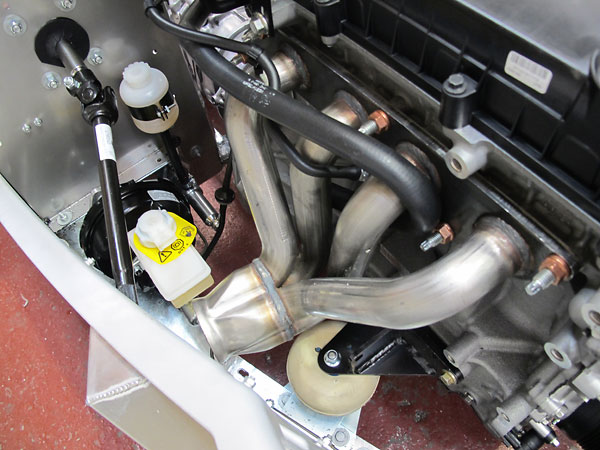
�
Exhaust header, motor mount, and master cylinder details. Incidentally, Morgan was one of
�
the first automakers to make catalytic converters standard across its range. More trivia:
�
to pass U.S. and specifically California emissions regulations, from 1974 though 1991 all
�
United States market cars were converted by independent dealers to run on propane. After
�
that, Morgan met U.S. emission requirements by using Rover's electronic fuel injection.
�
Morgan withdrew its Classic models from the U.S. market in 2006, due to difficulty meeting
�
supplemental restraint (airbag) requirements. Importation of Aero models continued until
�
2008 when a special exemption for rear crashworthiness certification expired.
�
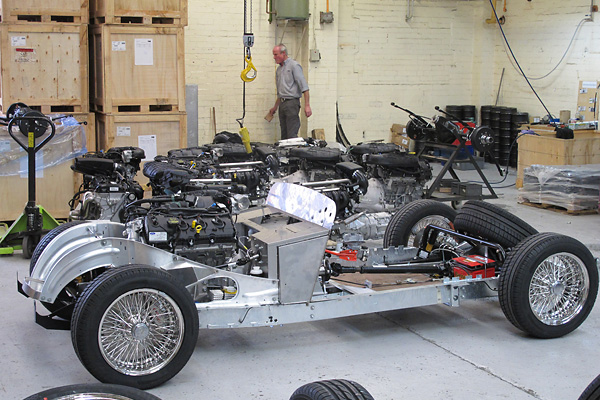
�
More powerful and wider than the 4/4, the Plus 4 model is "The world's favorite Morgan."
�
The Plus 4 model designation dates to 1951. Early Plus 4 cars had Standard's Vanguard
�
2088cc engines, which were rated 68bhp. Current Morgan Plus 4 cars use Ford Duratec
�
1999cc 4-cylinder engines which produce 145 bhp at 6000rpm and 140 lb/ft of torque.
�
40.4mpg combined average fuel economy rating. Width 1720mm. 1933# dry. £30,238 plus VAT.
�
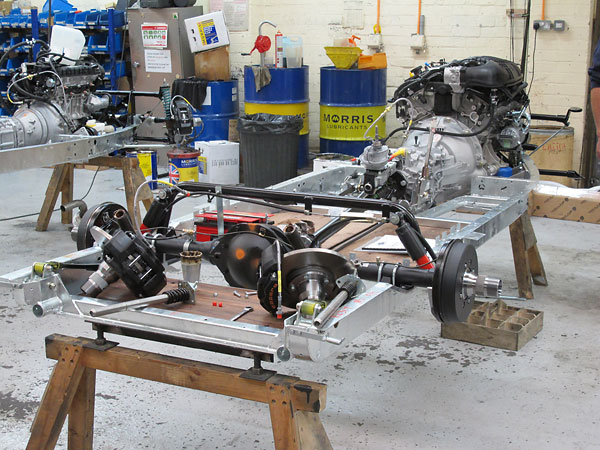
�
Here we see a 3.7L Ford Cyclone V6 and a Ford 6-speed manual transmission, so we know
�
we're looking at Morgan's "Roadster" model. The V6 engine produces 280 bhp at 6000rpm
�
and 280 lb/ft of torque, while providing a 28.8mpg combined average fuel economy rating.
�
Dry weight: 2094#. Width 1720mm. £38,250 base price, plus VAT.
�
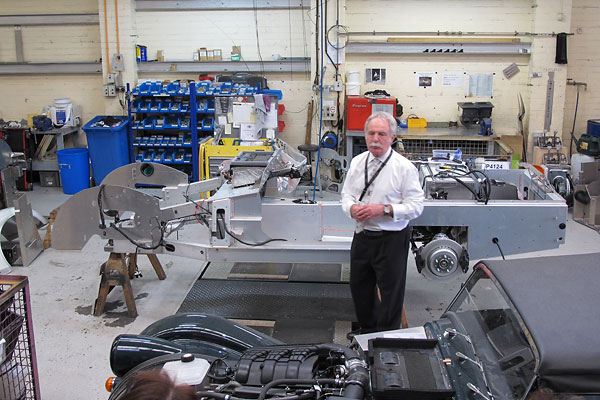
�
Of the Plus 8, Morgan says: "It weighs just 1100kgs, yet meets European safety standards."
�
Its body is shared with the Classic range, but its aluminum chassis is shared with the Aero
�
range. It features a BMW 4799cc V8 engine with the customer's choice of either a BMW 6-speed
�
manual or a ZF 6-speed automatic transmission. The engine is rated 367 bhp at 6500rpm
�
and 370 lb/ft of torque. The car delivers 23mpg (manual) or 26mpg (automatic) combined
�
average fuel economy. Width 1751mm. Dry weight 2425#. £71,000 base price, plus VAT.
�
�
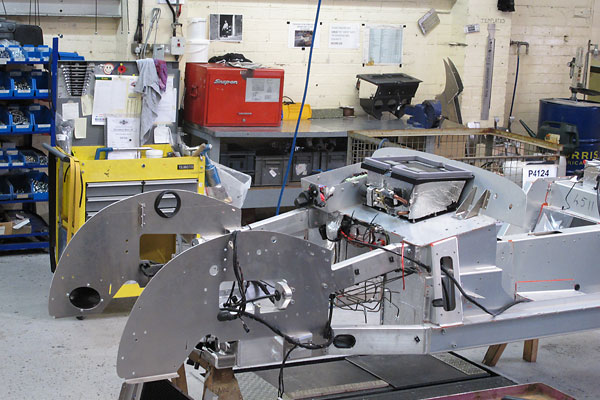
�
According to the Morgan website, all current car models measure ~4010mm in length.
�
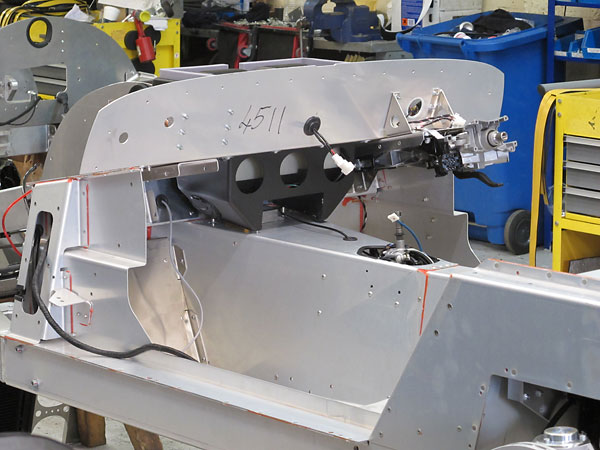
�
The aluminum chassis of the Aero range and the Plus 8 are built by Radshape Sheet Metal Ltd.
�
in Birmingham from 10-gage (~2.5mm thick) aluminum held together by heat-cured Alcan AVT
�
adhesive. A small number of spot welds help hold the chassis together until it's bonded.
�
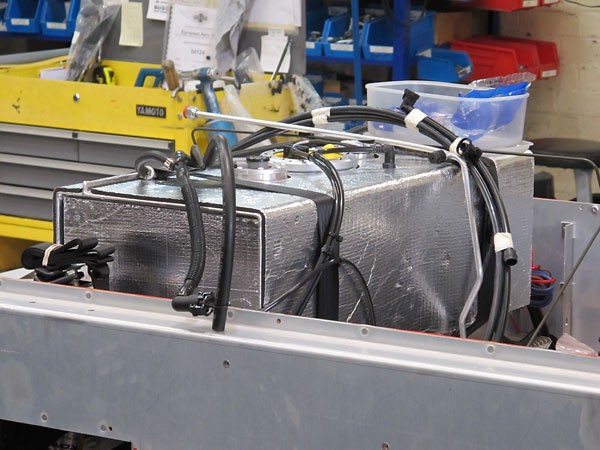
�
Fuel capacity: ~18.5 U.S. gallons.
�
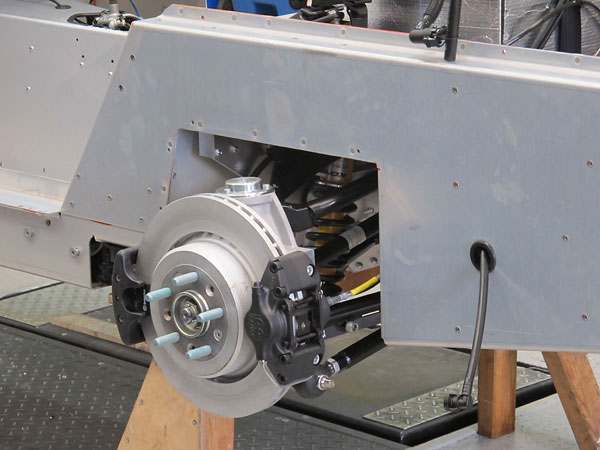
�
Independent rear suspension featuring long wishbones and aluminum uprights. If you had
�
x-ray vision, you'd see something very unusual: the coilovers are fully floating! In
�
other words, they're connected to control arms at both ends - inboard at the top and
�
outboard at the bottom. There are no anti-sway bars. Carefully selected spring rates
�
and a very low roll center are reasons why they aren't considered necessary.
�
Note: the second brake caliper is for a hydraulically operated parking brake.
�
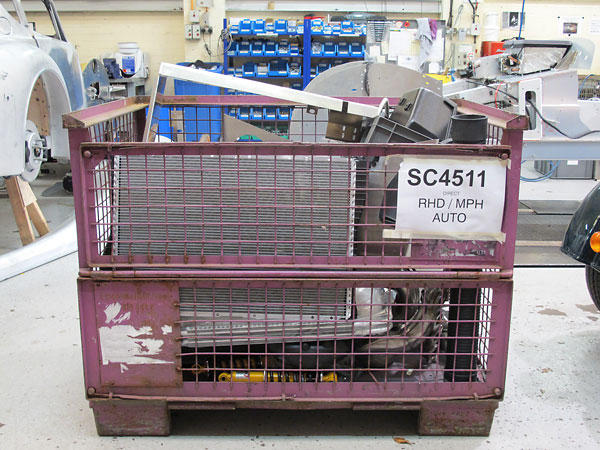
�
Each chassis is assembled by a single technician who works from a bin of parts, as photographed.
�
| �
Enjoying this article? Our magazine is funded through the generous support of readers like you! � To contribute to our operating budget, please click here and follow the instructions. � (Suggested contribution is twenty bucks per year. Feel free to give more!)� |
�
Wood Shop
� �
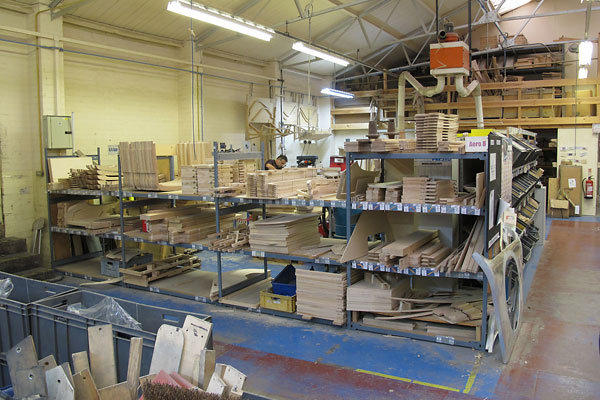
�
Although the earliest Morgan three wheelers used French black poplar for body subframes, Morgan
�
soon switched to ash wood. Belgium was traditionally Morgan's preferred source, despite occasional
�
problems with embedded WWII-era shrapnel. In very recent years, trade with the Far East has brought
�
fungal spores for which European trees lack natural immunity. First in Europe and now throughout Britain
�
a fungus called Chalara is wiping out commercial reserves. The fungus causes rapid dieback of foliage.
�
In just a few years, sixty to ninety percent of British ash trees will be killed.
�
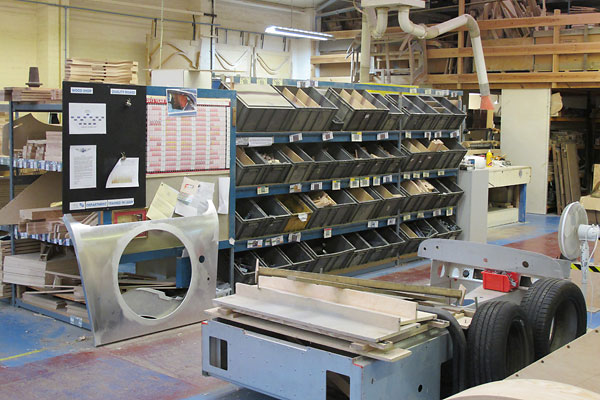
�
Ash trees killed by fungal infection may be harvested because the quality of the wood isn't affected, but
�
supply lines are collapsing. Meanwhile in America, the larvae of an Asian beetle known as the emerald
�
ash borer are destroying billions of ash trees and their wood. American ash isn't suitable for Morgan's
�
use anyhow because our varieties grow too fast (with more widely spaced growth rings).
�
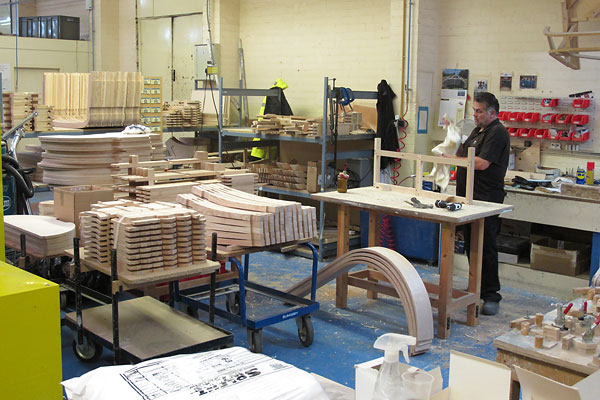
�
Strength, toughness, straight grain, and a minimal number of knots are basic characteristics Morgan
�
requires - but they also require wood that can be formed to shape. See the curved parts in this photo?
�
The more gently curved parts in the center were formed in bag presses: a plastic film is set over the
�
wood and a vacuum pump pulls the film and wood into shape. Deeper curves are formed with
�
mechanical clamping. (See below.)
�
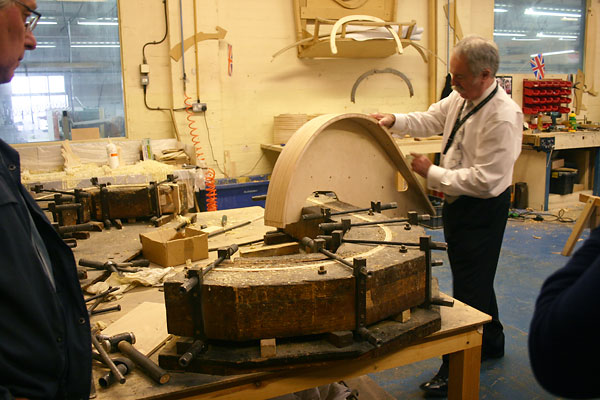
�
The sweep of Classic series Morgan rear fenders has remained unchanged since the 1950s.
�
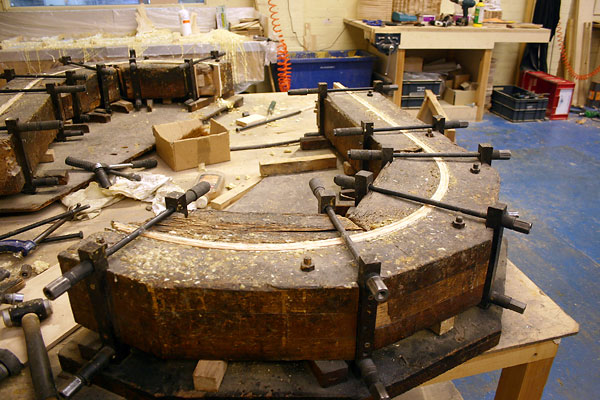
�
In fact, for over six decades countless Morgan rear fenders have been formed on these
�
two simple fixtures. The trick is that they're comprised of three layers of wood. Each layer
�
is about 1/4" thick. They're glued together to a total assembled thickness of about 3/4".
�
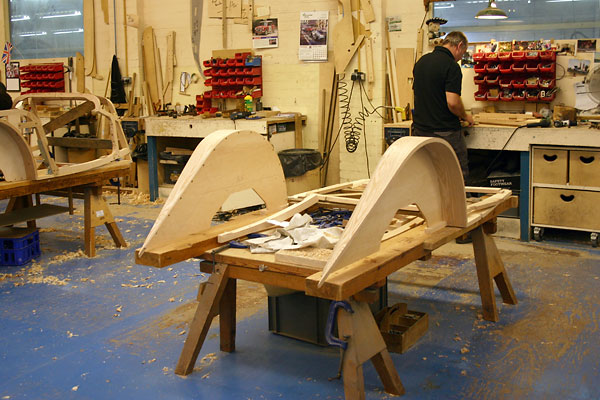
�
The cure time of the glue that's currently used is about six hours, which limits production
�
of Classic series cars to about two per day. After the glue cures, the rear fender arches
�
are trimmed to width on a bandsaw. The width required varies from model to model.
�
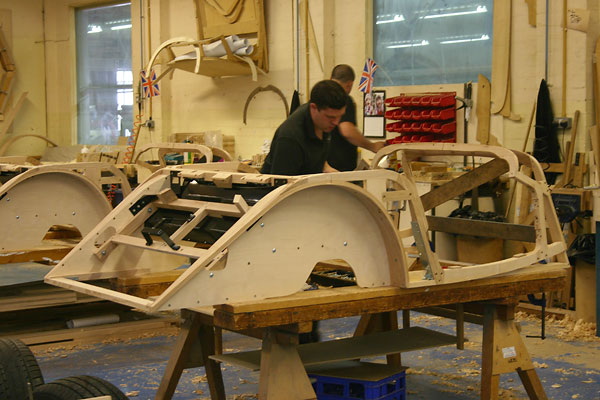
�
Rear fender arches are just one example of formed wooden parts.
�
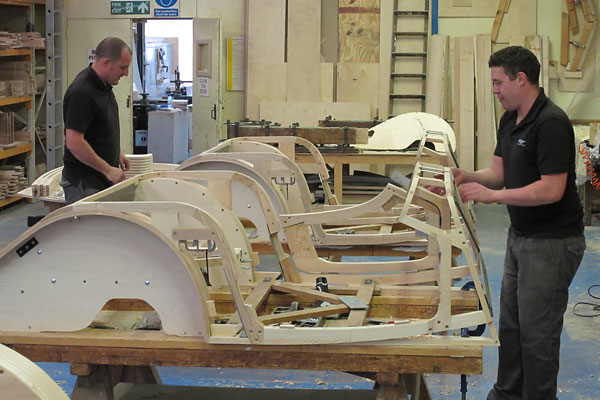
�
Morgan employs approximately 177 people. Nearly all of them started with the company
�
as apprentices. The result is an exceptionally well seasoned and loyal workforce.
�
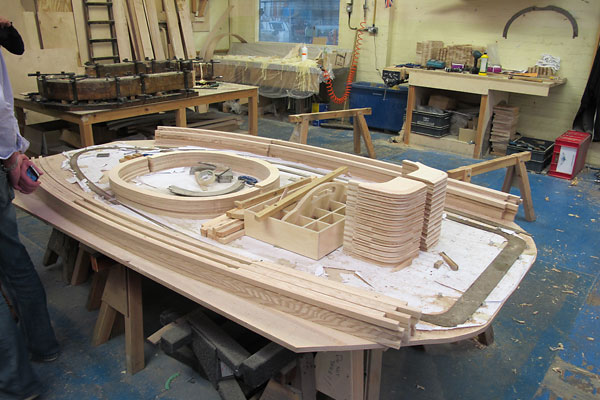
�
Three wheeler body subframes are assembled on this table. You can see how
�
various wooden members have been kitted together in preparation.
�
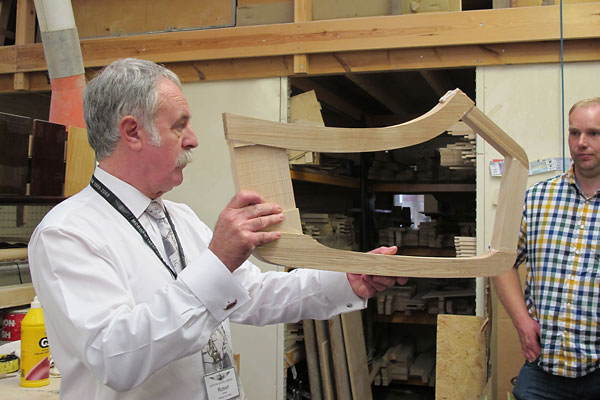
�
Classic series doors are much more elaborately shaped than most people realize.
�
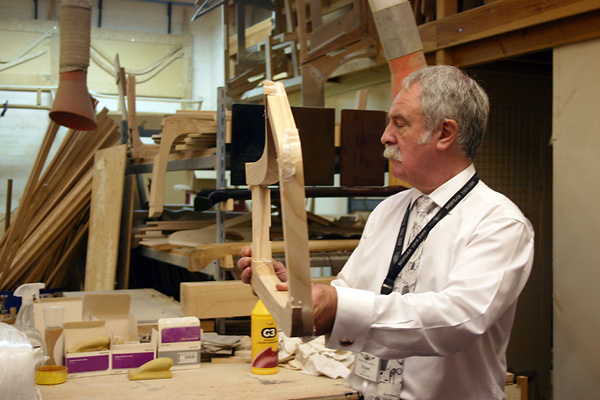
�
The door surface curves from top to bottom and from front to back. This curvature
�
is achieved with precision by use of a CNC milling machine after initial fabrication.
�
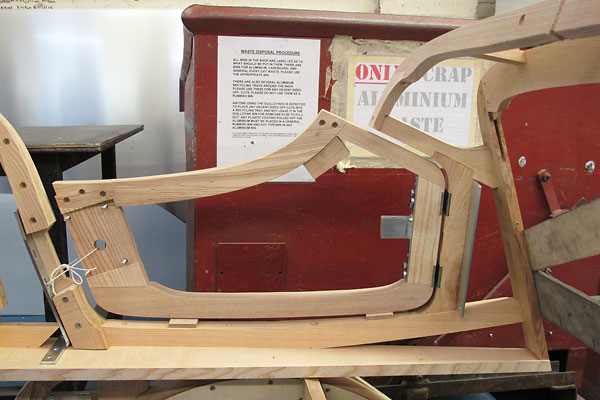
�
For side-impact protection, a piece of steel tube will be installed between the door
�
hinge and latch. (That installation occurs after the car is paneled and painted.)
�
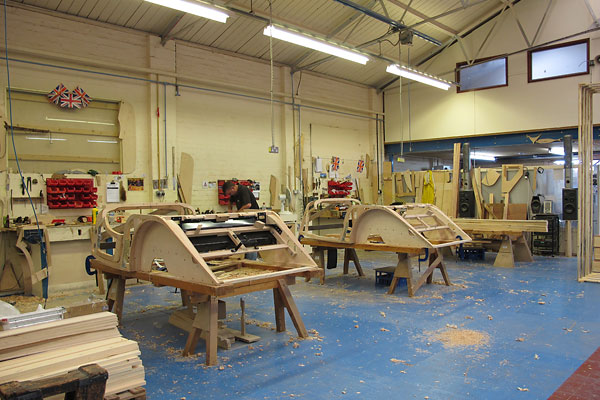
�
Every Morgan car is accompanied by a build book as it travels through production. Each
�
production stage has its respective page. As technicians complete their work, they autograph
�
the book. For an extra charge, Morgan includes photographs of the car's assembly.
�
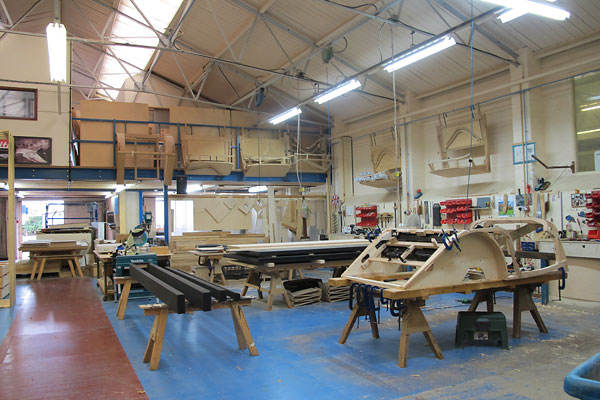
�
�
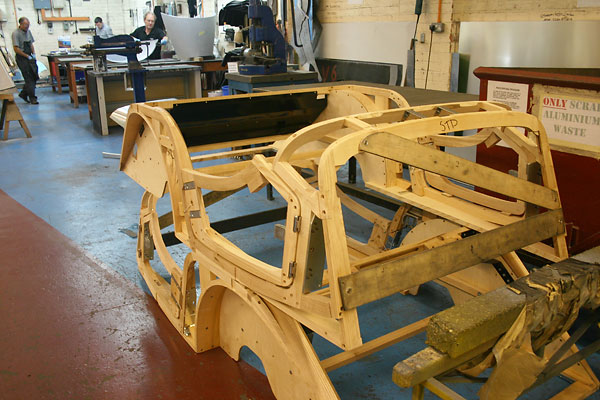
�
After being made in the wood shop, ash subframes are sent out to be dip-treated for
�
enduring protection from rot. These two are back, ready to be paneled by hand.
�
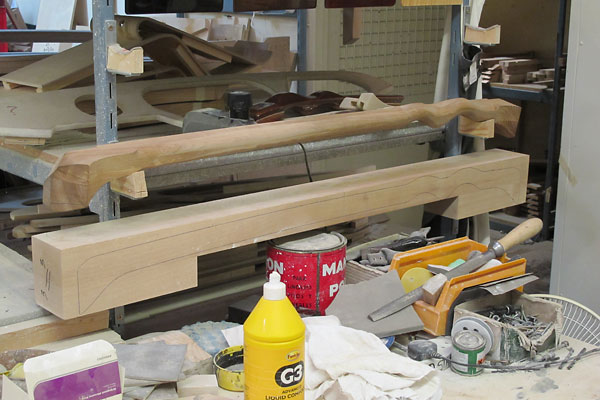
�
Morgan Aero dashboard caps are CNC milled from ash wood.
�
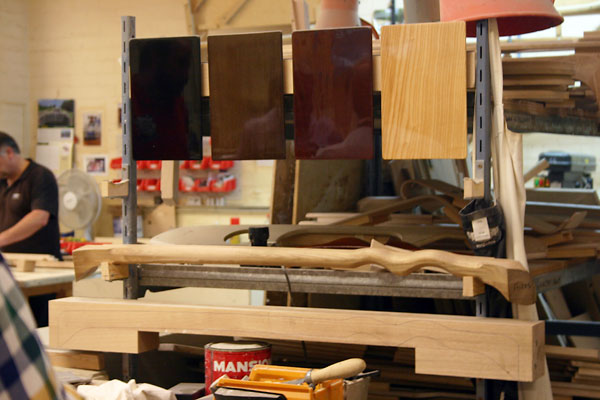
�
Customers may choose between four color options. Left to right:
�
raven, tawny, brown velvet, and natural ash.
�
Panel Shop
��
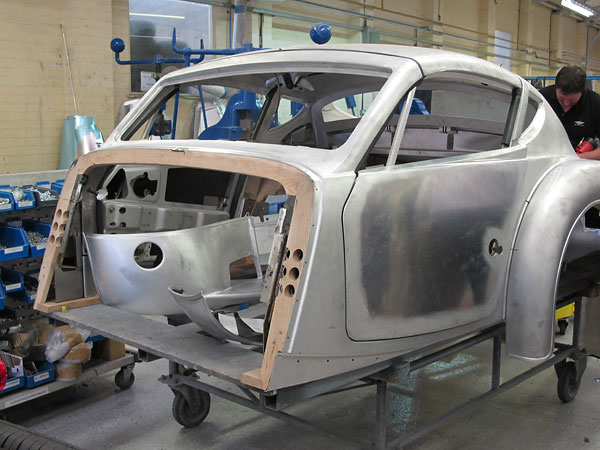
�
Even on the top-of-the-line Aero models, aluminum body panels are tacked to ash wood. This
�
Aero Supersport is "an advanced supercar designed for practical long distance touring."
�
It features a BMW 4799cc V8 engine with the customer's choice of either a BMW 6-speed
�
manual or a ZF 6-speed automatic transmission. The engine is rated 367 bhp at 6500rpm
�
and 370 lb/ft of torque. The car delivers 23mpg (manual) or 26mpg (automatic) combined
�
average fuel economy. Width 1751mm. Dry weight 2601#. £105,750 base price, plus VAT.
�
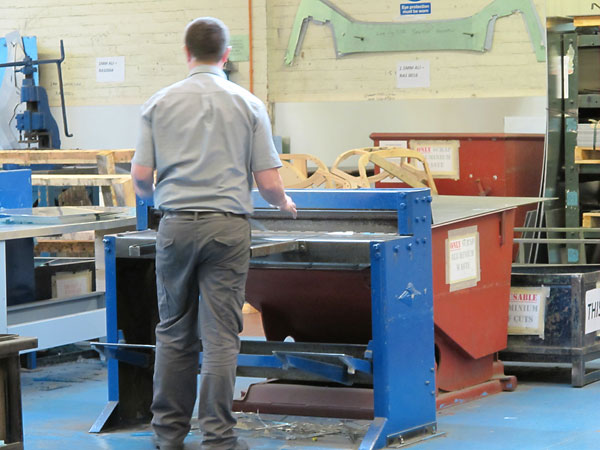
�
In recent years, Morgan has increasingly utilized laser cut blanks from outside suppliers
�
rather than cutting aluminum to shape in-house. Still, a number of small foot operated
�
shears like this one are necessary for low volume and custom work.
�
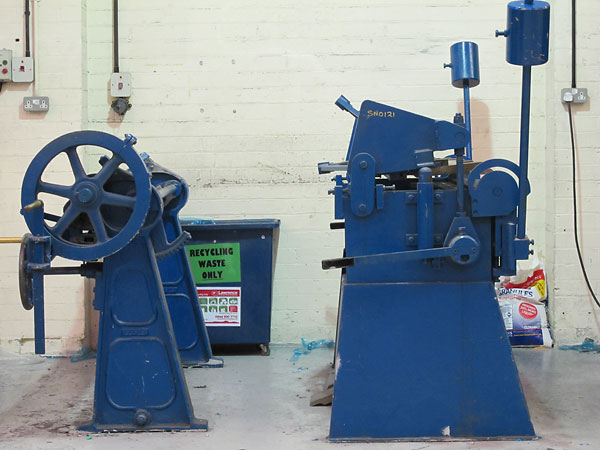
�
Two robust, manually operated machines: a slip roll (left) and a cornice brake (right).
�
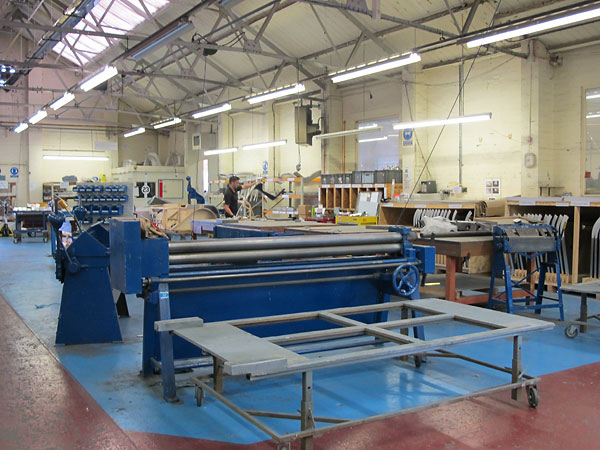
�
A large, motorized slip roll.
�
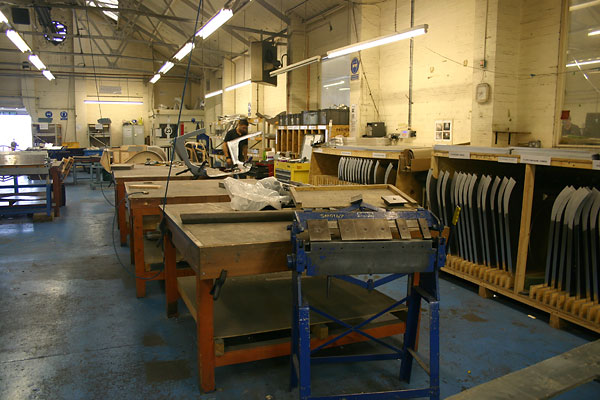
�
A handy little box and pan brake.
�
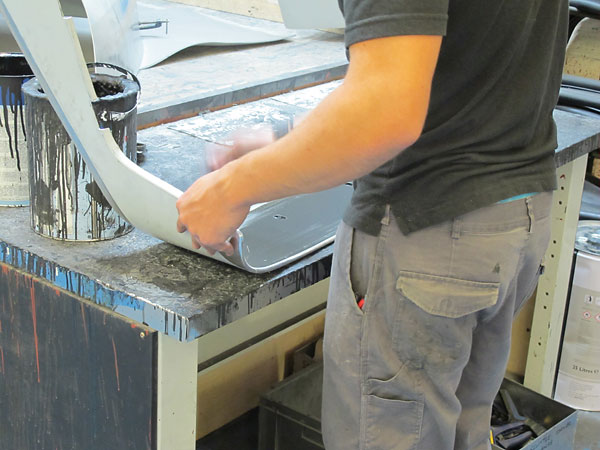
�
Mastic sound deadener is applied by brush to the underside of a Classic series cowl.
�
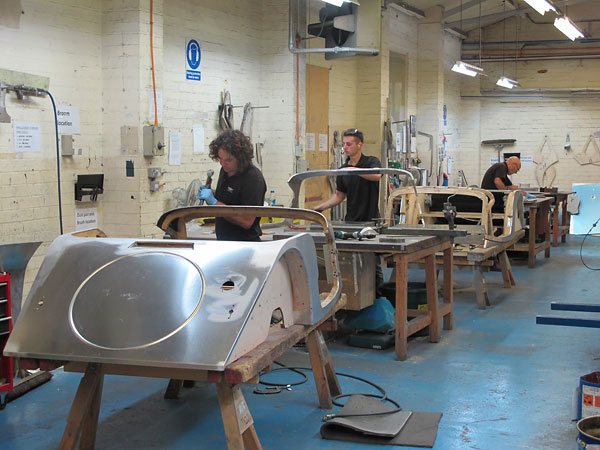
�
Fitting cowl panels.
�
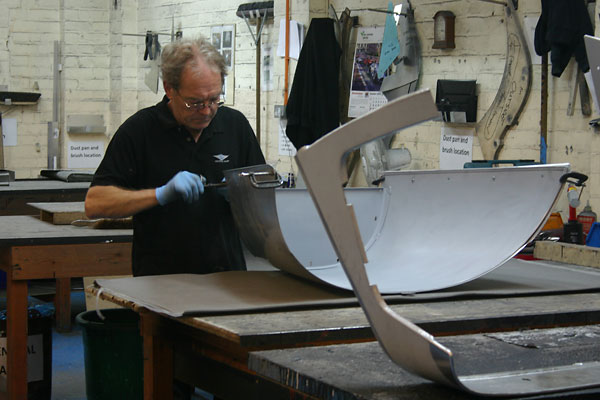
�
Fabricating a Three Wheeler bonnet.
�
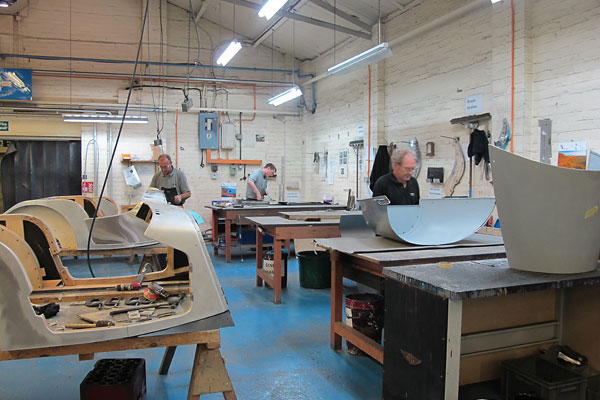
�
A second Three Wheeler bonnet has been completed.
�
�
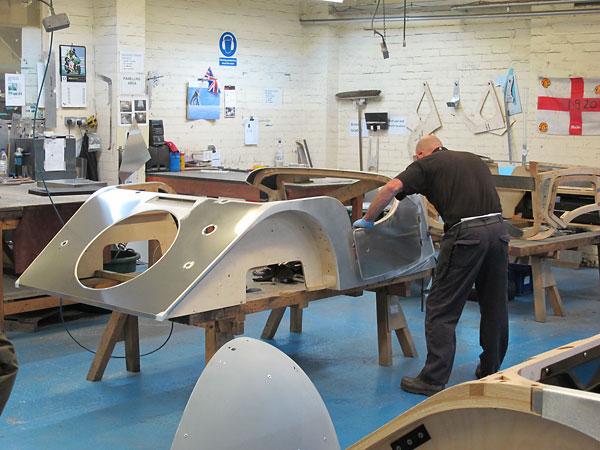
�
Fine tuning door fit with a few taps of a small hammer.
�
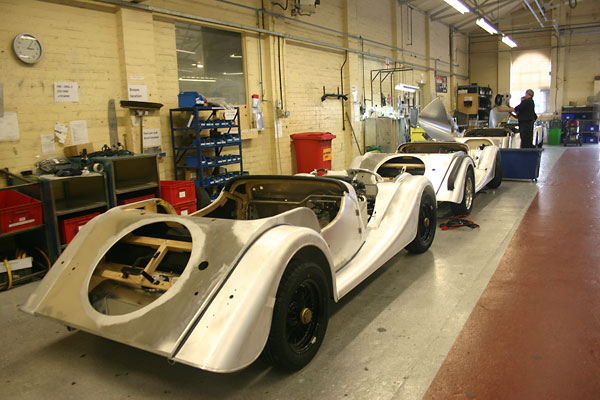
�
We missed a photo opportunity; I don't have a snapshot of a body being set down
�
onto a chassis. Once the two are mated, a custom bonnet can be fabricated.
�
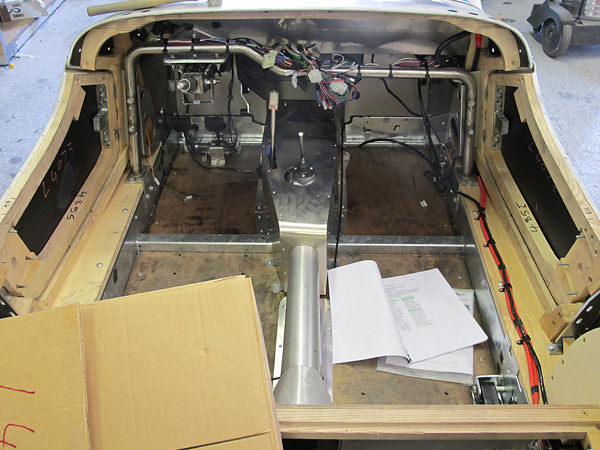
�
Tubular stainless steel dashboard and steering column support.
�
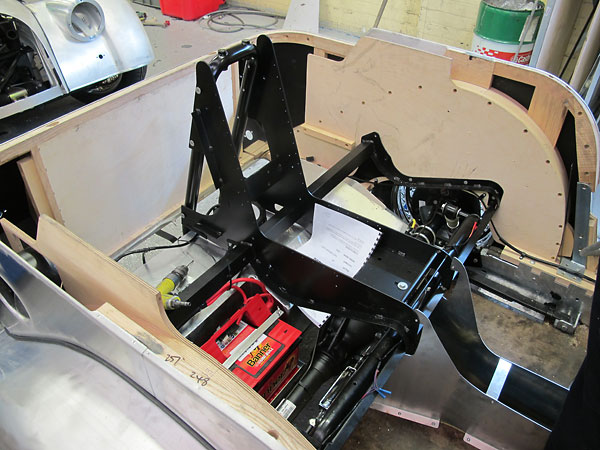
�
The structure that supports the back seat of a four seater Morgan.
�
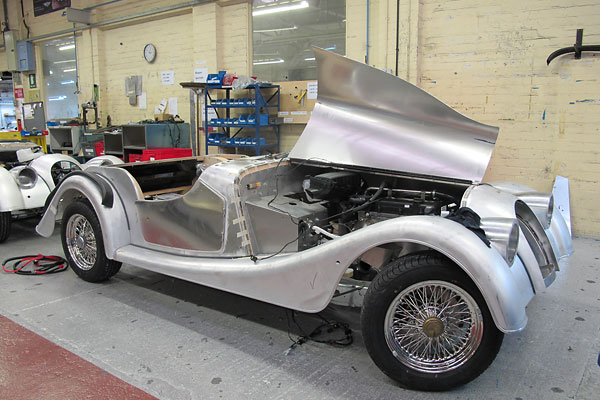
�
Classic series bonnets are still made and trimmed one-at-a-time by very highly skilled craftsmen.
�
Wings and cowls are no longer made by hand; instead they're formed using the SPF (blow molding)
�
process, similar to how the Aero bodywork is constructed.
�
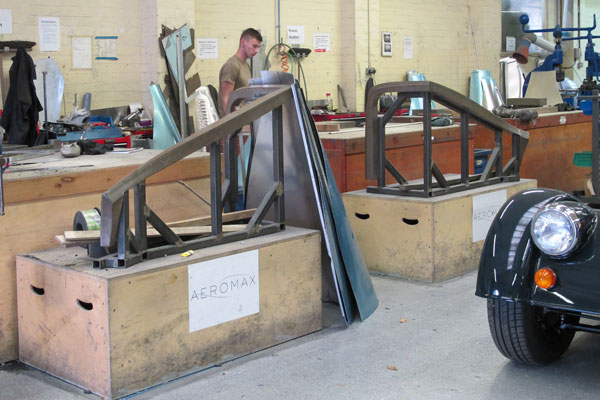
�
A supply of bonnet blanks have been roll formed to basic shape, but they still
�
need to be precision trimmed. Then hinges and latches may be installed.
�
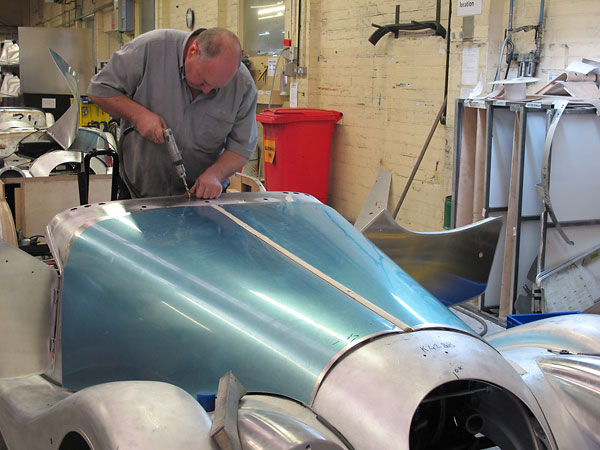
�
While the bonnet is being fitted a few other parts are installed here,
�
including climate systems and transmission tunnels.
�
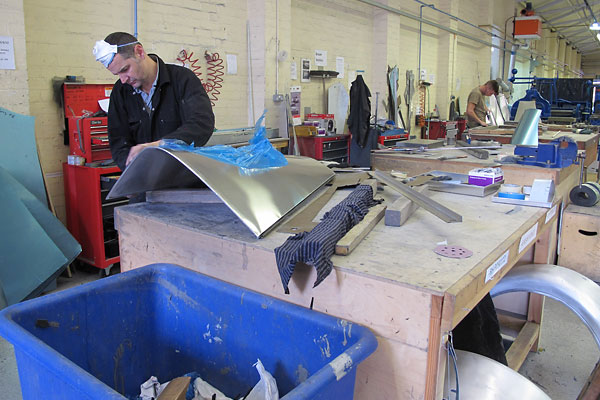
�
(I'm not sure what the guy in the foreground is doing, but the guy in the
�
background is installing a piano hinge down the center of a butterfly hood.)
�
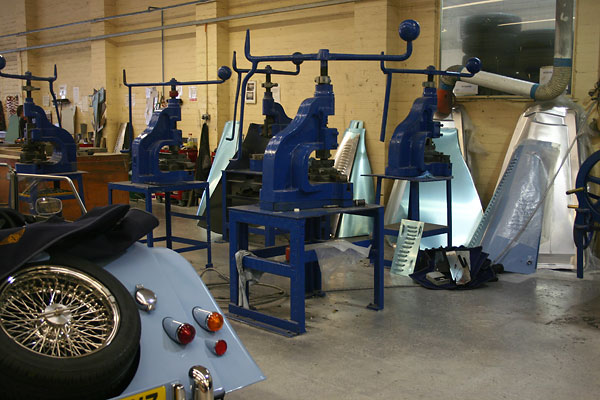
�
Apparently, these five fly-presses are used to stamp louvres of five different lengths.
�
The presses are hand operated and only stamp one louvre at a time.
�
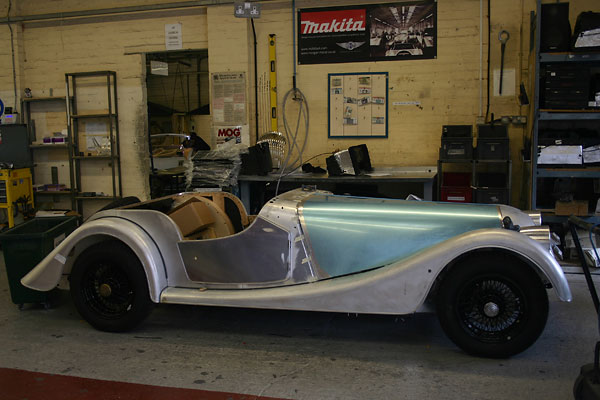
�
Morgans have been raced since very early days, and lady drivers have been particularly
�
important in their racing history. Gwenda Stewart began a campaign of record breaking
�
runs at the Montlhery circuit near Paris in 1929. She was incredibly quick, breaking 44
�
records and eventually managing an average speed of 115.66mph. Prudence Fawcett,
�
the daughter of a Sheffield solicitor, entered her 1098cc Coventry Climax powered
�
Morgan 4/4 racecar in the 1938 24 Hours of Le Mans. Sharing driving duties with
�
Morgan agent Dick White, she completed the race at an average speed of
�
57.2 mph (and with a best lap speed 65mph) to finish 13th overall.
�
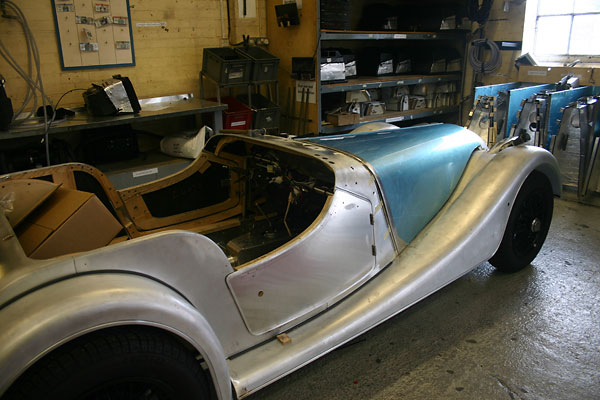
�
Morgan returned to Le Mans in 1962 with Christopher Lawrence and Richard Shepherd-Barron
�
in a Morgan Plus 4 racecar. Their average race speed was 94mph, with a fastest lap of 110mph,
�
That was good enough for a class win and for 13th place overall finish, after which Lawrence
�
drove the car back home. Morgan invited Christopher Lawrence back to manage another assault
�
on Le Mans shortly after they introduced their Aero 8 GT model in 2000. With DeWalt Tools
�
sponsorship, the Morgan team contested the 2002 24 Hours of Le Mans. They completed 181
�
laps before succumbing to mechanical problems.
�
Paint Shop
��
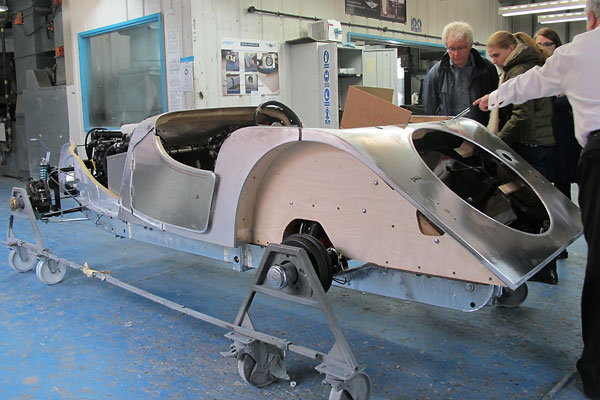
�
We stepped briefly into the paint shop, just long enough to see that wings and bonnets are
�
removed and cars are mounted on nifty trolleys for painting. Installing panels to check fit
�
and then removing them before painting is inefficient. Morgan is working to get variance
�
out of their build so they can streamline this. Note: Morgan was one of the first auto
�
manufacturers to convert to environmentally-friendly waterborne finishes.
�
| �
Enjoying this article? Our magazine is funded through the generous support of readers like you! � To contribute to our operating budget, please click here and follow the instructions. � (Suggested contribution is twenty bucks per year. Feel free to give more!)� |
Trim and Upholstery
��
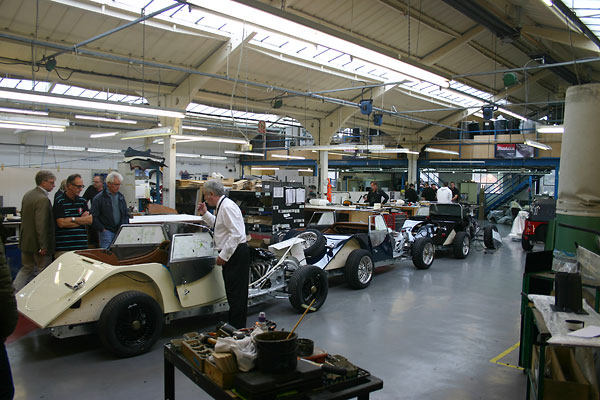
�
Electrical wiring and interior trim is installed before wings are reinstalled.
�
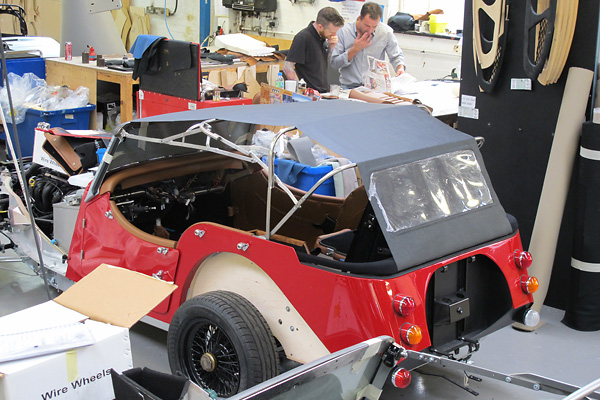
�
I imagine Morgan Four Seaters might be especially popular in Bermuda and other
�
island getaways. They're available in Plus 4 or Roadster drivetrain versions,
�
weighing 2044# or 2205# respectively.
�
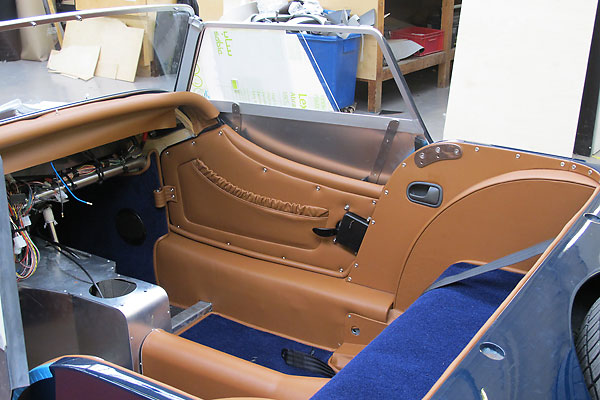
�
Morgan sources their leather from Scotland. There's very little barbed wire
�
in Scotland, so their hides include fewer scars.
�
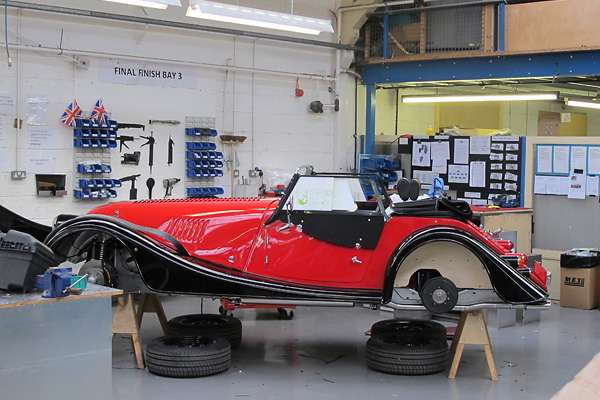
�
A rubber trim strip separates fenders from other bodywork. An extra
�
piece of this trim lays across this car's front fender.
�
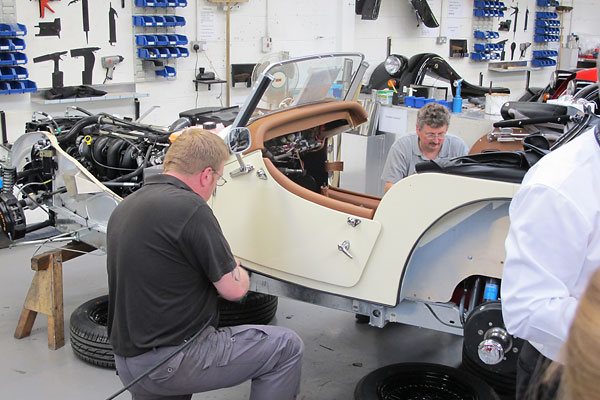
�
Morgan Motor Company has installed many different makes of engine over the years, including,
�
in roughly chronological order: J.A.P., Blumfield, Green-Precision, M.A.G., Anzani, Blackburne,
�
Matchless, Ford, Coventry Climax, Standard (Triumph), Rover, Fiat, BMW, and S&S. Additionally,
�
H.F.S. Morgan used a Peugeot engine in his first prototype, a Dorman engine was used in the 4-4
�
prototype before Morgan decided they preferred Climax engines, and a Buick "215" was installed
�
in the first Plus 8 prototype because Rover couldn't provide a sample expeditiously. A QinetiQ
�
hydrogen fuel cell and a Zytek Automotive electric motor have been installed in recent show cars.
�
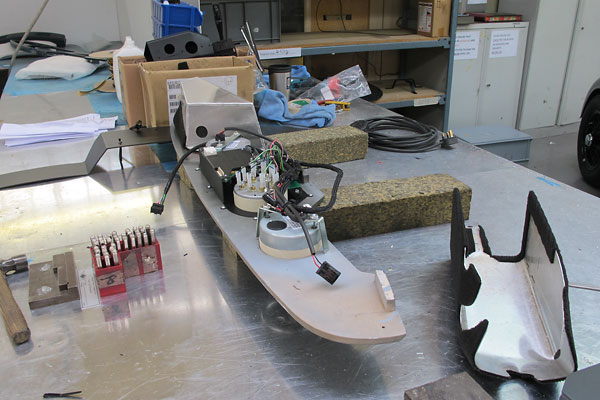
�
In an era when far too many automobiles have LCD touchscreens built into their dashboards,
�
I spent two hours in the Morgan factory and didn't see a single computer screen or
�
printer of any description. Study these photos and see if you can find one!
�
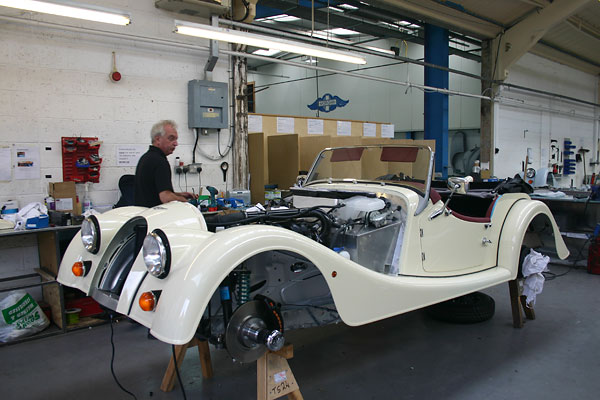
�
Morgan technicians use laptop computers to check and to program engine computers.
�
(I know it's true, but I didn't see that operation during my tour.)
�
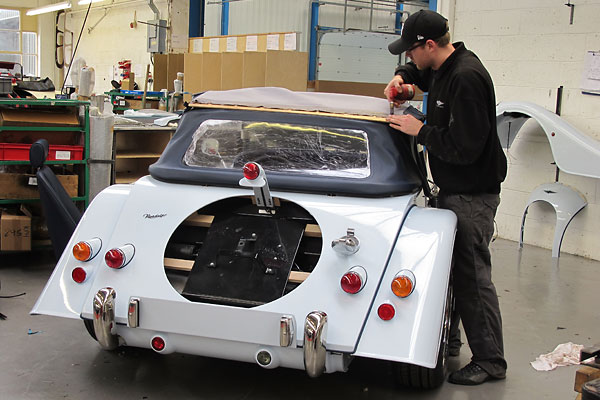
�
If a spare tire is mounted on the rear deck, the third brake lights is
�
mounted on a stem instead of being neatly recessed.
�
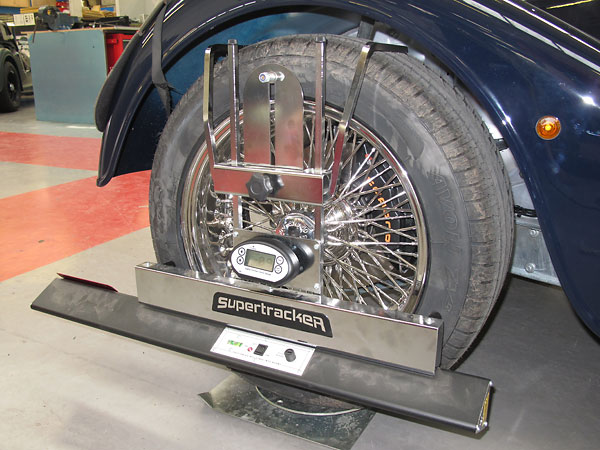
�
Morgan uses Supertracker (Made in U.K.) laser suspension aligners and MWS wire wheels.
�
�
�
| �
Did you enjoy this article? Our magazine is funded through the generous support of readers like you! � To contribute to our operating budget, please click here and follow the instructions. � (Suggested contribution is twenty bucks per year. Feel free to give more!)� |
Three Wheeler Production
��
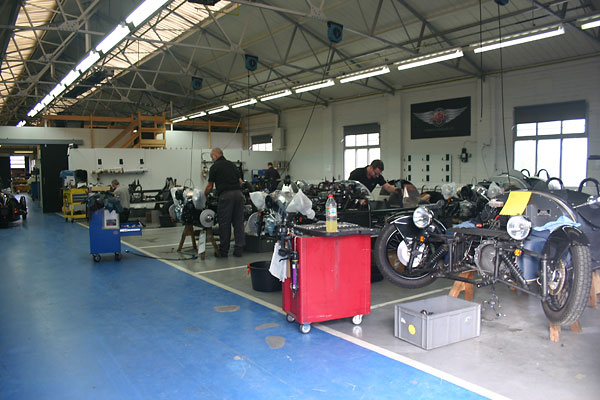
�
Morgan Three Wheelers are assembled in these few workshop bays.
�
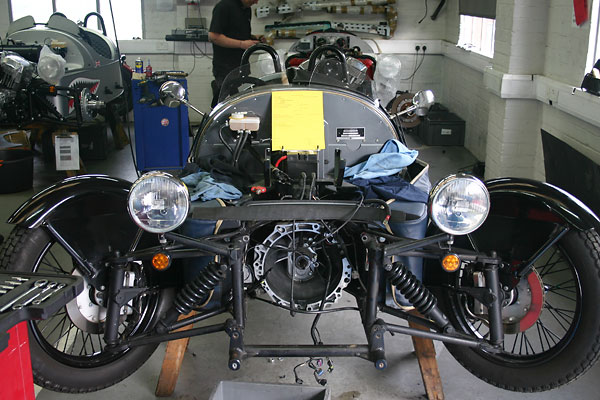
�
This photo reveals a huge departure from previous Morgan practice. The new Three
�
Wheeler features wishbones and coilover shocks in lieu of sliding pillars!
�
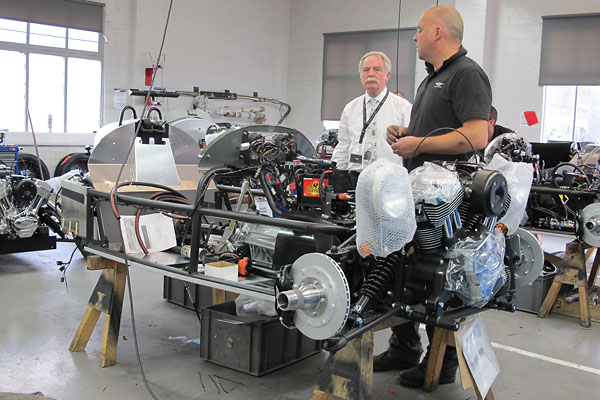
�
A recent Morgan press release says for 2014 they've redesigned the Three Wheeler chassis
�
to be stiffer. This must be the "before" picture. Curved tubes. No triangulation at all.
�
No stressed skin. This frame could be so much lighter and so much stiffer, so easily.
�
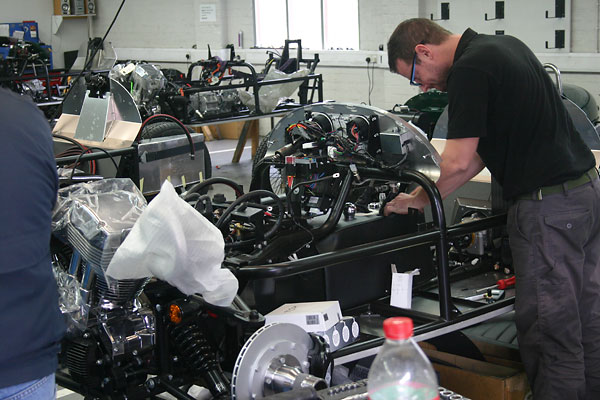
�
The Three Wheeler fuel tank is generously sized. With over eleven U.S. gallon
�
capacity, cruising range is approximately 450 miles.
�
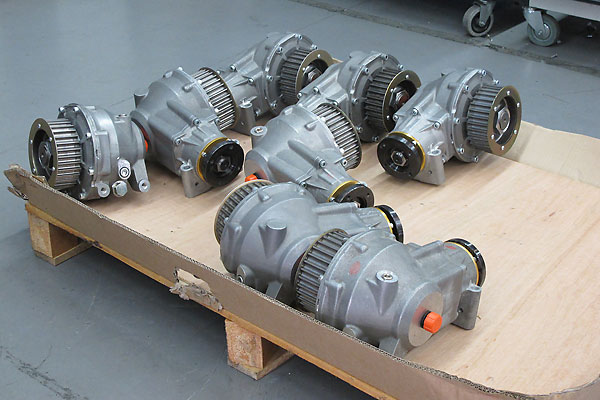
�
Another change announced for 2014: bevel boxes will be isolated from the chassis
�
to reduce noise, vibration and harshness ("NVH") complaints.
�
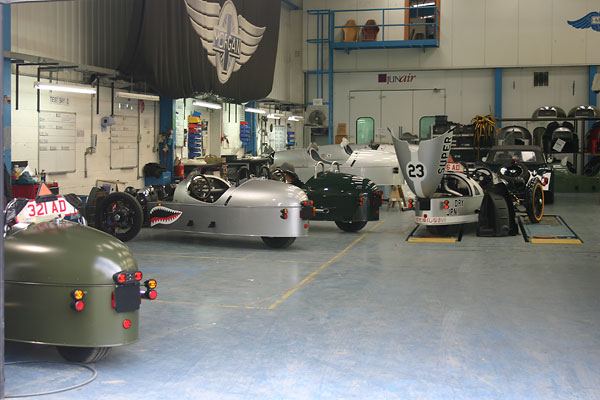
�
Morgan offers many vinyl wrap graphic options. They've even teamed with a fashion clothing
�
company to market special edition Three Wheelers with garish kanji character graphics.
�
Pre Delivery Inspection. Repair bay. Despatch bay.
� � �
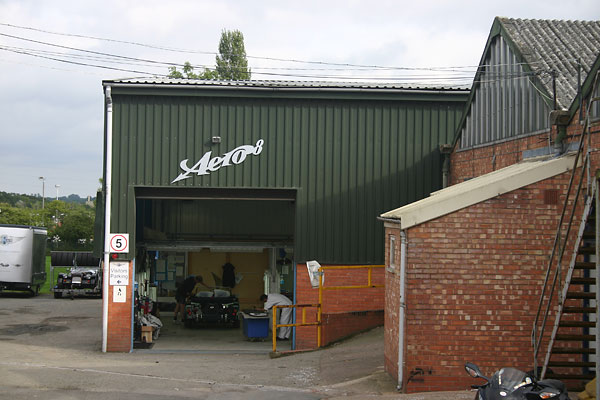
�
All Morgan cars are road tested, then given a complete technical PDI. Repairs are made,
�
and then underbody corrosion protection is applied. One more inspection, and then
�
the vehicle is prepared for shipment. Many Morgans are shipped directly to customers.
�
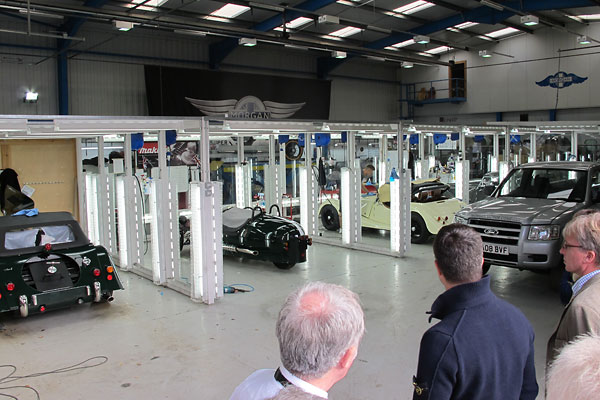
�
Vertically mounted florescent lamps are extremely helpful for paint inspection.
�
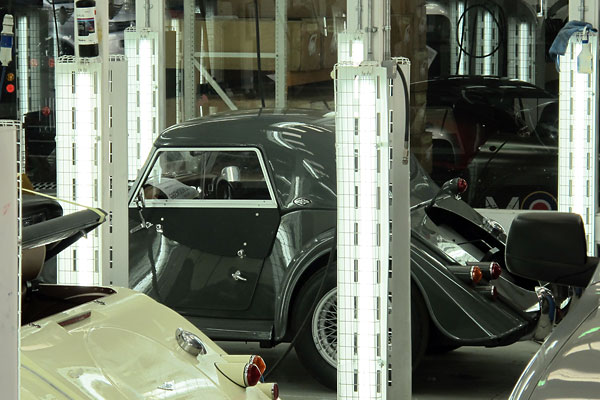
�
Apparently most Morgan customers prefer soft tops. Fiberglass hardtops like this one
�
are a factory option. Our guide reckoned this was the second one he had ever seen.
�
The Morgan Motor Company Museum
��
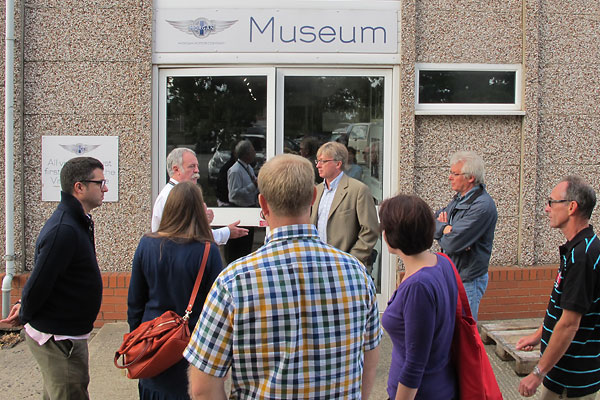
�
Morgan Motor Company Museum: open Monday-Thursday 8:30am-5pm & Fridays 8:30am-2:30pm.
�
Entry to the company museum and gift shop are free. Morgan cars may be rented here too!
�
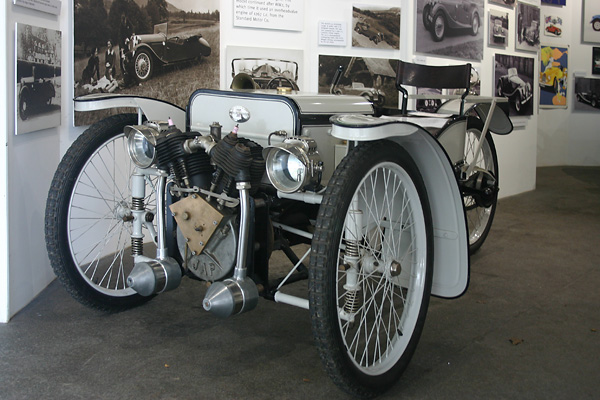
�
Built by Morgan archivist Martyn Webb, this is an accurate replica of Morgan's first production
�
three wheeler. Webb sourced many genuine pre-WW1 parts to complete it. The 1910 "Runabout"
�
model had a single seat and was powered by a J.A.P. eight horsepower V-twin which drove
�
the rear wheel. By selecting between two chain-and-sprocket sets, the driver had two forward
�
speeds. There was no reverse. To its credit, this one of the first production automobiles in
�
the world with independent front suspension. About 20 were built. None have survived.
�
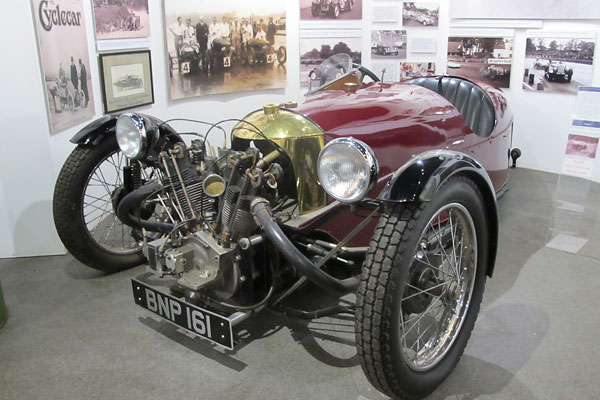
�
Harry Morgan initially considered both three and four wheel designs. He chose to build
�
three wheelers because of to their lower cost. His very first prototype was built in
�
1909, in the Malvern College workshops. Production started two years later.
�
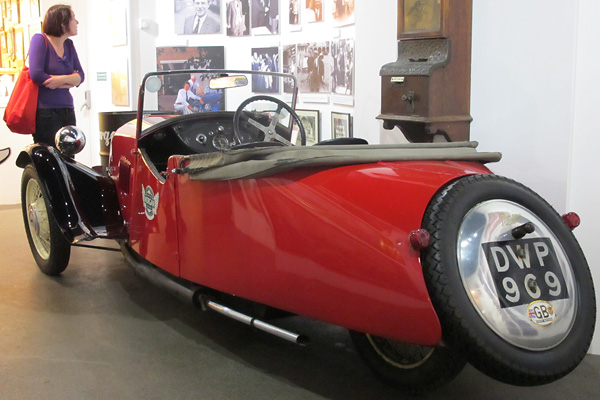
�
By 1932, Morgan three wheelers were equipped with 3-speed transmissions and a reverse gear.
�
Morgan's F-type (of 1935) featured a Ford side-valve engine under a conventional bonnet.
�
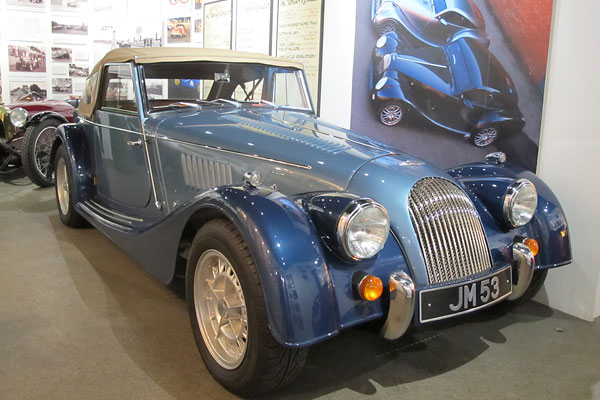
�
This car belonged to Peter Morgan's wife. According to our tour guide, it
�
was the first Morgan built with an automatic transmission.
�
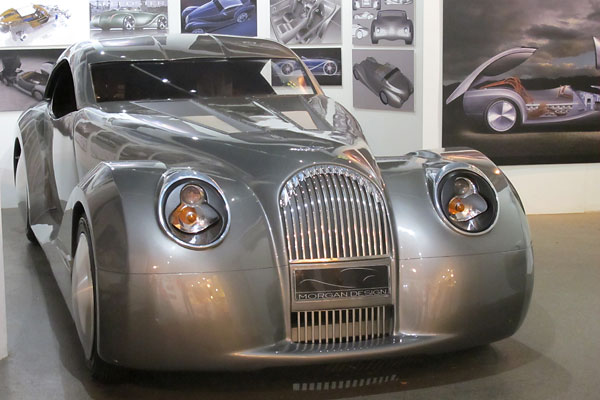
�
This is Morgan's original "LIFEcar" (LIghtweight Fuel Efficient car) prototype. When this prototype
�
was shown at the 2008 Geneva Motor Show, Morgan and its technology partners envisioned a
�
hydrogen fuel cell powered supercar with no tailpipe emissions. That version won't go into
�
production. In 2010, Morgan announced that the project had evolved and that a new
�
LIFEcar 2 model would feature a more immediately practical series hybrid drivetrain.
�
Morgan hoped production would start in 2012. It may happen yet.
�
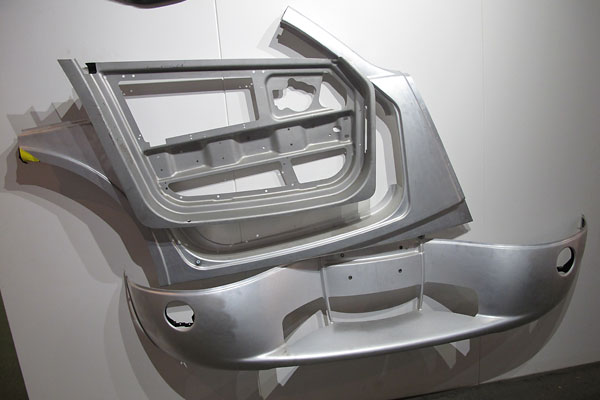
�
Superform Aluminium in Worcester provides three dimensionally formed exterior panels,
�
created via a process known as Super Plastic-Form (SPF). In a nutshell, aluminum sheet
�
is heated to 450C and is then blown into and/or around a one-sided cast steel form.
�
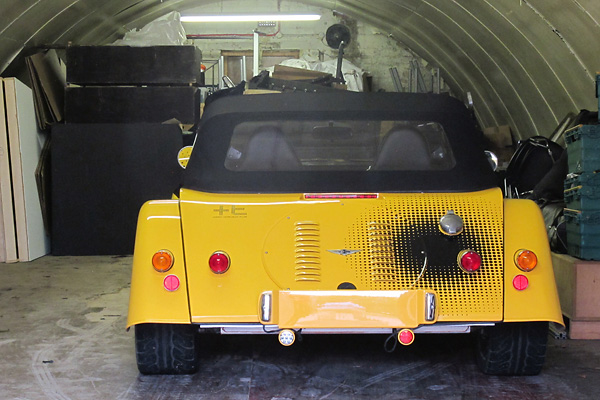
�
This Morgan "Plus E" all-electric promotional prototype debuted at the 2012 Geneva Auto Show.
�
Its Zytek Automotive electric motor produces ~94 bhp and 280 lb-ft of torque; enough for a
�
sub six second zero-to-sixty score. Interestingly, Morgan employed a Mazda five speed to
�
keep the motor's output in its sweet spot and to make the car more entertaining to drive.
�
Down side: the lithium ion batteries employed bring the curb weight of 2756 pounds,
�
which is about 330# more than a current Morgan Plus 8. Range: ~120 miles of smiles.
�
�
�
Disclaimer: This page was researched and written by Curtis Jacobson.�
Views expressed are those of the author, and are provided without warrantee or guarantee.�
Apply at your own risk.�
�
Photos by Curtis Jacobson for BritishV8 Magazine. All rights reserved.�

 �
�
